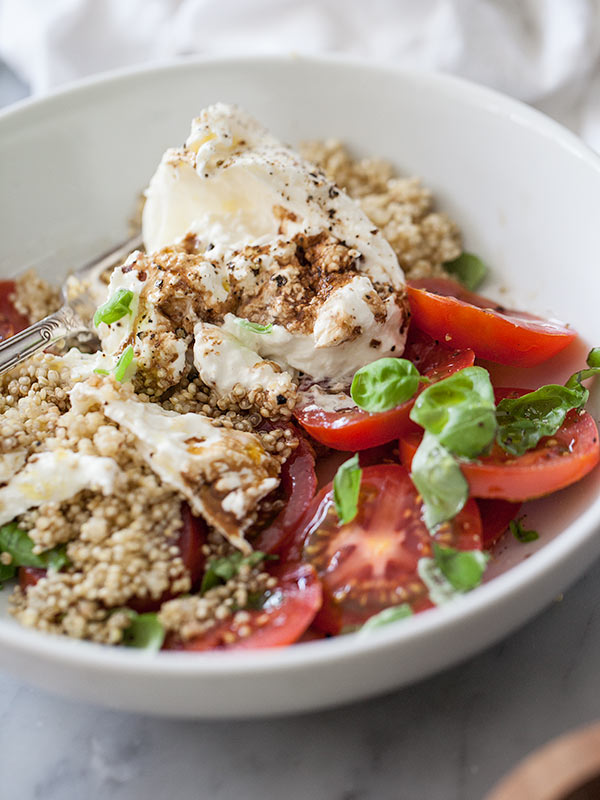Everyone’s favorite caprese salad with tomatoes, basil, and creamy burrata cheese gets a protein boost thanks to the addition of healthy quinoa. There are few ingredients that have made as big a splash on the current food trend scene, with as quick of a rise in popularity—and I’m not talking bacon here—than the superfood we call quinoa. It’s pronounced, keen-wa, but I’ve heard tongue-tied foodies say kwiin-wa and even kwin-O-uh. However it’s name passes your pearly lips, quinoa has definitely made an impression on food bloggers and their recipes. Heck, it’s made an impression on the world, with 2013 being named the “International Year of Quinoa” by The United Nations General Assembly thanks to its potential to assist in eradicating world hunger. Quinoa is an ancient grain, revered as a staple in the diet of the pre-Columbian Andean and Incan people who harvested it over 7,000 years ago. But until the past few years, quinoa was anything but a favored alternative to potatoes, rice and pasta. It wasn’t the chosen one cuddling up to the grilled chicken on your plate. But I’m here to tell you my theory on what helped change that. I first became aware of these pearly little nuggets at least 15 years ago when I was the art director of a national health food magazine. We wrote plenty of articles extolling the virtues of this nutrient-dense, gluten-free grain, preaching it’s health benefits as a superfood because it is a complete protein thanks to its nearly perfect ratio of ratio of carbohydrates to proteins to fats. A grain with high protein content. Now we’re talking superfood. It’s not like I didn’t learn about it’s magic properties, but did I try it? No, I didn’t. Why not? The name simply sounded a little weird, a little too medieval (what IS an ancient grain?) and I was just fine with keeping my evolving culinary horizons within reach of convincing my husband to try brown rice and Mediterranean couscous. Oh yes, I was happening my friends. So why has quinoa seen such an upsurge in popularity in recent years? Chefs and retailers are always looking for something new to showcase, to develop, to sell so we may be seeing it more, but that doesn’t mean people know what to do with it. I think the secret to quinoa’s success may owe a big thank you to the emerging popularity of food blogs and the authors behind them who make nutritious recipes that are approachable and delivered by a friendly, whole foods face. Si vous réalisez cette recette, n’hésitez pas à me le faire savoir ! Laissez une note ⭐️⭐️⭐️⭐️⭐️ pour cette recette ci-dessous et laissez un commentaire, prenez une photo et tag me on Instagram Instagram PinterestTwitter

Ingrédients
- 1 boule de fromage Burrata emballée
- 2 tomates moyennes (, coupées en tranches (j'aime les tomates Campari, à moins que je n'en aie de fraîches de mon jardin))
- 1/2 tasse de quinoa (cuit)
- 1 1/2 cuillère à soupe d'huile d'olive extra vierge, bonne et fruitée
- sel casher et poivre noir fraîchement moulu
- 5-6 feuilles de basilic (émincées)
- 2 cuillères à café de vinaigre balsamique
Instructions
- Disposer les tranches de tomates dans un saladier ou une assiette. Retirer la Burrata de son emballage et égoutter l'eau. Déchirer délicatement la boule de fromage en deux, en réservant une moitié pour une autre salade ou un autre usage (le fromage égoutté doit être utilisé dans la journée suivant son égouttage). Ajouter le quinoa et les feuilles de basilic et arroser d'huile d'olive et de vinaigre balsamique. Assaisonner avec le sel casher et le poivre fraîchement moulu et servir.
